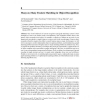Free Online Productivity Tools
i2Speak
i2Symbol
i2OCR
iTex2Img
iWeb2Print
iWeb2Shot
i2Type
iPdf2Split
iPdf2Merge
i2Bopomofo
i2Arabic
i2Style
i2Image
i2PDF
iLatex2Rtf
Sci2ools
DAGSTUHL
2006
2006
Many-to-Many Feature Matching in Object Recognition
One of the bottlenecks of current recognition (and graph matching) systems is their assumption of one-to-one feature (node) correspondence. This assumption breaks down in the generic object recognition task where, for example, a collection of features at one scale (in one image) may correspond to a single feature at a coarser scale (in the second image). Generic object recognition therefore requires the ability to match features many-to-many. In this paper, we will review our progress on three independent object recognition problems, each formulated as a graph matching problem and each solving the many-to-many matching problem in a different way. First, we explore the problem of learning a 2-D shape class prototype (represented as a graph) from a set of object exemplars (also represented as graphs) belonging to the class, in which there may be no one-to-one correspondence among extracted features. Next, we define a low-dimensional, spectral encoding of graph structure and use it to mat...
| Added | 30 Oct 2010 |
| Updated | 30 Oct 2010 |
| Type | Conference |
| Year | 2006 |
| Where | DAGSTUHL |
| Authors | Ali Shokoufandeh, Yakov Keselman, M. Fatih Demirci, Diego Macrini, Sven J. Dickinson |
Comments (0)

